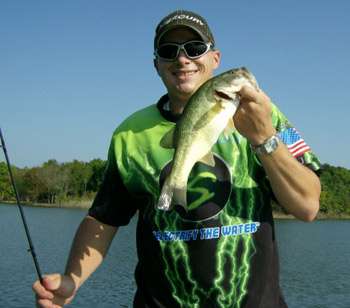
Football season is just underway, but the football jig should have found a place on the end of your line even during the heat of summer. Heat and humidity sap enthusiasm, as do lethargic bass seeking deeper, cooler, more oxygenated water. Some fishermen forgo the summer bite altogether and hang up their rods until cooler temperatures return in the fall — about the middle of football season.
Kory Johnson of Carthage, Mo., is not one of those fishermen. The creator and owner of Thunderstruck Jigs (www.thunderstruckjigs.com) can be found hopping a football jig around the rocky structure of Table Rock Lake even on the hottest days of the year.
Casting toward a dropoff in 20 feet of water, Johnson says, “I’ve found that you can get bit on a jig just about anytime of the year. Bass love crawfish and a jig resembles nothing so much as it does a crawfish. Anytime you’ve got a lot of rocky structure and deep water, a jig, especially a football jig, will usually produce.
“For me,” he adds, “Once fish have gone deep in summer, I look for deep bluff ends and ledges or points with chunk rock scattered on them.”
Johnson stops long enough to cross the eyes of a fat two-pounder that mistook his jig for a crawfish. He plays the bass to the boat while explaining his retrieve style.
“I let that fish tell me what kind of retrieve he wanted. I usually anticipate the hit on the fall. If there’s no hit, I’ll start hopping the jig on the bottom with short pauses. Sometimes they’ll hit on the first hop. Other times they’ll wait until you bump a rock or stump. When you feel that rock, let the jig sit — don’t be afraid to let it sit there for 15 seconds or more. If a bass is following it, then he’s curious. When you retrieve it, give it a few slight shakes, and hop it again. You might get that reaction strike.
“Also, your retrieve depends on the steepness of the bank. You really want the jig to make contact with the bottom quite a bit. Generally, by keeping your rod tip between 10 and 11 o’clock you’ll get that bait moving a few inches to a foot or so at a time along the bottom. Sometimes, moving it just a few inches will cause it to fall several feet if you’re fishing steep dropoffs. Just adjust your retrieve to the bottom.”
Taking a short break from the 104-degree heat, Johnson explains the importance of the proper tackle.
“An important thing for me to remember when jig fishing is never to outcast or overextend my equipment,” he says. “I’ve pretty much settled on a 7-foot, medium-heavy rod with a stiff tip.
“As far as line is concerned,” he adds, “I like 12-pound-test fluorocarbon for several reasons. I fish a lot of clear water, and fluorocarbon almost disappears in water. It also has great sensitivity, which is important for interpreting bottom structure and detecting subtle strikes. And, since it’s abrasion-resistant, it comes in handy around rock. Plus, fluorocarbon’s got limited stretch for a quick, solid hook set.”
Johnson connects with another fish off the end of a long, rocky point. At the boat, he quickly releases the bass and holds up the finesse jig.
“Color is important when jig fishing,” he explains, nodding to the jig and adding, “This is a finesse jig and trailer combination I came up with for Thunderstruck, and it’s been successful. The color is Grape Pumpkin with a green pumpkin/red and purple flake beaver-type bait as the trailer. I’ve trimmed off all but 10 or so of the strands on the back.
“But sometimes this particular color doesn’t work. Then I have to let the fish decide what they want. Generally, in clearer water, it’s best to stay with natural colors — greens, browns, etc., with maybe a little bit of orange. In stained or muddy water, it seems that black and blue are most productive the world over — maybe add a little chartreuse or bright orange. Overall, though, experiment with the seasonal colors that are most common for the crawfish in your region.”
But there’s more to a jig than color.
“The bulk of the skirt and weight of the jig influence the bait’s action and fall,” Johnson says. “A bulkier skirt is good for colder water because it slows the jig down. As the water warms, bass sometimes like livelier bait with less profile. I like a jig with a skirt I can trim back for more finesse presentations — that’s why my jigs come with 80-strand skirts instead of the standard 40-strand we often see on the shelf. I think it’s important for fishermen to have the option of customizing their own jigs.”
Several more chunky bass that day helped Johnson prove that football jigs can be productive on even the hottest days of the year, especially in clear water with plenty of rock. By matching the forage, using the right equipment and sticking with it, the dog days can give us something to cheer about.




